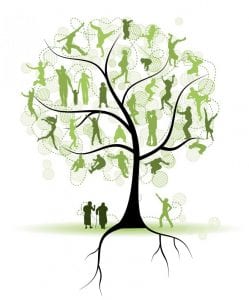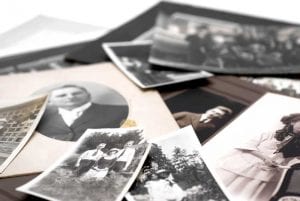Family Research Hints Part II
 This is the second part in a series from the Miramichi Genealogy Society. Click here to read Part I.
This is the second part in a series from the Miramichi Genealogy Society. Click here to read Part I.
by Penny Creamer
Last time you determined why you wanted to work on your family tree and were given optional methods for doing it. Now we’ll provide a few places where you can locate information you’ll need to make your family tree grow.
Family Members
Elderly relatives are often able to recall a wealth of genealogical information. If they are very elderly and/ or possibly not quite healthy, don’t put it off for too long. You may lose this very important source. Phone and make plans to visit them. Notification in advance makes them think about the family and they are better prepared to answer your questions when you visit. Ask short, direct questions—and LISTEN. Take notes or use a tape recorder, or both. Use discretion when recording information gathered in this manner.
Try to ask the same questions to different family members and compare responses. People are affected by incidents in different ways and so they tend to remember things according to their own personal perspectives. Try to document, or otherwise verify, any information uncovered. Remember, memories are very selective. If you write to family members from away to obtain information, be sure to identify yourself, explain your interest, and include a stamped, self-addressed envelope. Email is faster and probably more commonly used today, but it doesn’t always produce the same detailed results. With a written request, it is usually helpful to include family group sheets containing the information you already have and asking them to fill in the blanks where you still need information.
Don’t be too hopeful of obtaining results on a first attempt. You may have to follow-up with another letter or a phone call to get the information you want. Friends and neighbours of the family may also be helpful and able to provide information and photos.
Family Bibles
A family member, especially an older family member, may have a bible with births, deaths, and other family information recorded in it. At one time, it was the treasured method of noting important events that helped shape a family. And, mothers and grandmothers usually kept better records than doctors, ministers or government officials.
 Birth, marriage, death or other certificates
Birth, marriage, death or other certificates
Families, especially mothers, often save certificates of all kinds. By asking around in the family, you may locate birth certificates, baptism certificates, health condition/ treatment certificates, confirmation certificates, graduation certificates, achievement diplomas, marriage certificates, (and today divorce certificates), death certificates, etc. There is someone in every family who treasures those little bits of paper.
Wedding invitations/ Birth announcements
Wedding invitations contain a lot of information, such as parent names and residences, bride and groom full names, date of marriage, location of marriage, official performing the marriage, reception plans and location, etc. and may contain a photo. Birth announcements too are sometimes sent out to inform folks of a new addition to the family. They include the baby’s gender, name, birth date, birth place and may also contain a photo.
Newspaper articles/ clippings
You should be able to find at least one member of your family (maybe several), who has clipped out and saved newspaper articles or other information about your family. It could include birth announcements, engagement announcements, weddings, anniversaries, birthday celebrations, obituaries, and funeral announcements. You may also find articles concerning school events, sports involvement, awards, hobbies, organizations, volunteer activities, work/ business or other occupational information, photos, etc.
Wills/ Deeds/ Business registers, etc.
Often, tucked away in a shoebox in the closet or attic, are old wills, property deeds, mortgage or other loan information, insurance documents, old business registers, etc. These old documents could lead to information regarding location, family members, occupations, financial status, or more. No doubt someone in your family has been unable to throw them out.
 Diaries
Diaries
Always a treasure when one is located.
Letters/ cards
Letters (cards and postcards) were used to keep in touch with family and friends years ago (before phones and email). They may contain information that would not otherwise be found and, if located, could prove to be invaluable.
Photos
Every family member you get in touch with will probably have photos. A note of caution, though. Be sure to get all the information you want before you start going through photos. Arrange to get copies of the photos you want, AND BE SURE TO RETURN THE ORIGINALS. Photos can either be scanned into the computer or copied. Laser copies are almost as good as originals and are relatively cheap to obtain. Photos are a wonderful way to trace family resemblances and to help bring long deceased ancestors back to “life”. Be sure to write names, dates and other information on the back of each photo so you can identify them later.
NBGS-Miramichi Branch hopes you find this information helpful. Good luck with your family tree and take time to enjoy getting to “know” your ancestors.
If you would like to join us, we meet the fourth Tuesday of every month (except July, August and December) at the Chatham Library at 6:15 pm. Contact us at: NBGS-Miramichi, PO Box 403, Miramichi NB, Canada E1N 3A8 or visit our website at www.nbgsmiramichi.org.
Next time we’ll list several other sources of information to locate and search.
Giv’er Miramichi is about “What’s up, what’s new, what’s happening”. We are focused on building people up, supporting one another and celebrating our successes.
